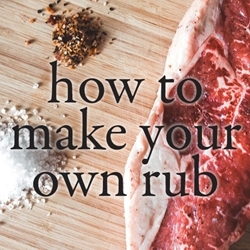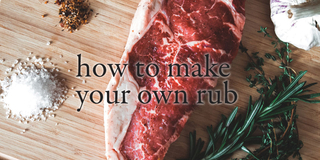How to Make Your Own Rub

One of the most flavorful ways to season meat is with a generous amount of rub. One of the questions that we hear often from our customers is - How to Make a Rub? A rub can be any combination of herbs and spices that appeal to your taste buds. There are no rules or exact recipes that need to be followed. Indeed, ingredients for tasty rubs will vary widely depending on personal tastes and preferences as well as geography.
Rubs can be made two ways, a wet rub or a dry rub. A wet rub is basically a dry rub mixture combined with a small amount of oil to make a thick paste. A wet rub has the advantages of adhering to the surface of the meat better than a dry rub and it will help the meat remain moist during cooking because the oil in the wet rub seals the surface of the meat.
A dry rub will need to be thoroughly rubbed into the surface of the meat to impart maximum flavor, but can be more convenient to use especially if you have made a large batch ahead of time and have it handy in the cabinet. A homemade dry rub mixture should be stored in an airtight container away from heat and light. It should remain fresh and flavorful for up to six months if stored properly. Eventually it will begin to lose flavor so it would be smart to label each batch with the date to avoid old mixtures taking up space in the cabinet (in a perfect would, rubs will taste so great they will not last that long). Until the rub making skill has been mastered, it would be wise to create rubs in smaller batches and record the ingredients and amounts used until you have achieved the desired results. This will avoid having wasted ingredients and a large supply of something on hand that is not working or heaven forbid, the opposite problem of creating the world's best rub and not remember exactly how it happened (I just hate it when that happens). Both wet and dry rubs should to be applied to the meat the night before or at least several hours before cooking to maximize the flavor.
Whether you choose a wet or dry rub, it is important to create a balance of flavors that will not overpower the meat. A good place to start is with sweet and salty ingredients. The sweet flavor can be regular granulated sugar, brown sugar, turbinado sugar, or molasses in the case of a wet rub. The salt can be from table salt, sea salt, kosher salt or any of the seasoned salts such as celery, garlic or onion. Salt should be added by weight not volume due to the differences in the size of the grind. The important thing is to balance the two in roughly equal amount of flavor according to taste.
The next level of flavor to add in a rub recipe is the heat. Heat can come from ground black pepper, cayenne pepper, chili powder, white pepper, crushed red pepper flakes or any combination of these ingredients. This part of a rub is purely a matter of taste and heat tolerance.
To finish off a great rub it is important to build the flavor by adding herbs and spices. This is where the originality comes in. Oregano and Thyme or a blend like Italian seasoning works well, especially for chicken. A mixture of cumin, garlic, dry mustard and paprika can be a wonderful combination to round out a rub and give a good barbeque flavor. If all else fails, an excellent method to complete an original rub is to line up all of your spices and herbs on the counter and add what you think will taste good. Mix strong flavors with milder or complementary flavors for best results. Experiment by adding different rub mixtures to beef, chicken and pork. The flavors of all kinds of meats are enhanced by using this type of slow seasoning. Again there are no rules; the perfect rub is the one that you and your family enjoy the most. .

